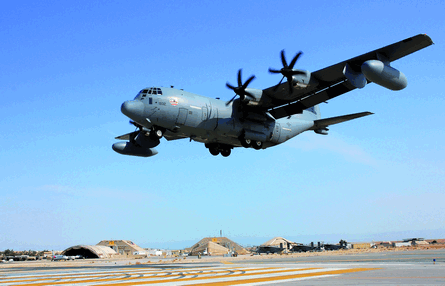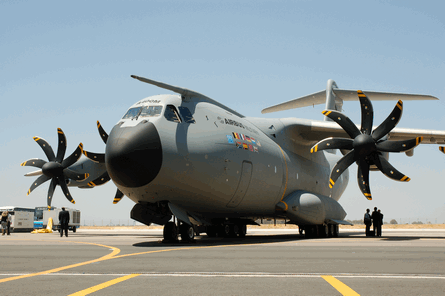Even in a time of increasing pressure on military budgets, few active production aircraft enjoy an outlook as good as the Lockheed Martin C-130J.
Within this year's third quarter, the US Air Force has finalised plans to not only continue buying the most modern version of the 55-year-old tactical airlifter for several years, but also to boost dramatically annual purchases.
At the minimum, the USAF has confirmed a plan to replace more than 200 ageing C-130Es with 172 C-130Js for the basic mission of combat delivery. With 89 aircraft already ordered, that means the USAF plans to buy another 83 aircraft. Negotiations between the USAF and Lockheed began in late August on a new multi-year procurement deal.
But that is likely to be just the beginning. The USAF inventory of C-130s of all types slightly exceeds 600 aircraft, and a vast portion must be either replaced or upgraded with new cockpits and centre wing boxes by 2020. The combination of requirements is creating a micro-economy within the defence industry, with new players vying to support this emerging need for at least the next decade.
 |
|---|
© USAF |
"This is necessary because these aircraft are needed for supporting the warfighter and our mission. It's the heart of our intra-theatre airlift," says Maj Gen David Gray, the USAF's director of acquisition for global reach, or mobility, programmes.
Beyond the combat delivery requirement, the multi-year contract in discussion could include pricing for another major USAF order.
The C-130J is also a leading candidate for replacing 115 HC/MC-130s used for refuelling combat search and rescue helicopters, a fleet operated by the special operations community. With the oldest of the 1960s-era HC-130s on the brink of retirement, the USAF was forced to buy 14 C-130Js in May before settling on an acquisition strategy to replace the entire fleet.
The Department of Defense has recently given the USAF authority to buy the first 74 aircraft, including the 14 C-130Js already acquired - although USAF officials say this initial purchase does not predispose them to select the C-130J for the remaining 60 aircraft.
The service plans to complete an acquisition strategy for the HC/MC-130 replacement by next September, in which buying more C-130Js will be considered as one of several options. A multi-aircraft competition, however, is unlikely.
The USAF has ruled out the L-3 Communications/Alenia Aeronautica C-27J Joint Cargo Aircraft as a direct C-130 replacement, although it may play a complementary role. And it is unclear if the Airbus Military A400M will be available in time to compete for the HC/MC-130 replacement contract.
 |
|---|
© Airbus Military |
The USAF instead is considering a mixed fleet of new-build C-130Js and rebuilt versions of older C-130Es. Under this strategy, a major contender is likely to be Columbus, Ohio-based Snow Aviation, which has modified a C-130E with new Pratt & Whitney PW150 engines and an aerodynamically improved wing. Wing-tip fuel tanks also extend the range, plus offer the side benefit of increasing the maximum take-off load in the cargo hold.
Snow's modified C-130E "has been looked at, okay, and that will be dusted off again", Gray confirms. Lockheed remains confident that the C-130J will account for at least 68 of the first 74 orders to replace the 115-aircraft HC/MC-130 fleet.
The company allows, however, that the remaining 41 replacement aircraft may represent a mix of new and old C-130Es.
Lockeed's final assembly line in Marietta, Georgia is expecting orders for new C-130Js to surge within three years. The USAF is only one potential customer, but is certain to be the largest. The second multi-year procurement deal, if approved, will also include the US Marine Corps, which is expected to match its previous order for 21 KC-130J tankers.
GROWTH AREAS
Foreign sales will continue to be an area of growth. Canada will finalise a deal by year-end to buy 16 new C-130Js, while India is to buy six C-130Js. The USAF is also reconstituting the Iraqi air force airlift fleet with an order of six C-130Js.
The result is a sharply rising production rate beginning when the current multi-year contract expires after next year. Annual output is on target to grow from 12 C-130Js this year to 16 in 2009. The number of deliveries then rises to 27 in 2010, and will continue to expand.
 |
|---|
© USAF |
"The line is tooled for 36 aircraft a year," says Jim Grant, Lockheed's vice-president of business development for global mobility and special operations forces. "We're excited to put some of those efficiencies back in the line."
The Marietta production line consists of 12 assembly positions, with each aircraft moving to a new position roughly every 21 days. By 2010, that should jump to a seven- to 10-day move rate using the same two-shift system, Grant says. Lockheed is to hire 800-1,000 workers within four years, augmenting 1,800 now assigned to the C-130 programme, he adds.
Lockheed has also approached major suppliers on the programme, which include Heroux-Devtek, Honeywell, Messier-Dowty and Rolls-Royce, to prepare them for the production rate growth.
At the same time, the USAF is about to begin upgrading 221 C-130Hs and 119 special-mission variants with new cockpits and new centre wing boxes. The latter upgrade requirement is likely to be another boost for the Marietta workforce, as Lockheed is the only company that now produces and installs centre wing boxes for USAF C-130s, Grant says. The USAF wants to start installing new structural kits at a rate of 27 aircraft a year after 2010.
Meanwhile, the avionics modernisation programme for the C-130 is about to enter a new competitive phase. Boeing originally won the development and production contract, but the award was later tainted by the Darleen Druyun acquisition scandal.
The USAF was forced to reopen the AMP contract to competition after Boeing completed development. Boeing, L-3 Communications, Lockheed and Northrop Grumman are among the most likely bidders to install the Boeing-developed cockpit system during the production phase.
AMP BIDDER SELECTION
The USAF plans to select at least two bidders next year for a "source familiarisation phase". This will allow competitors other than Boeing to install the AMP suite in two C-130s, with the hope of having at least three experienced bidding teams ready to compete in 2012 for the full-rate production phase.
"It's my belief that the air force will probably look for multiple sources for the installations," Grant says.
The AMP programme is limited to upgrading the 221 C-130Hs expected to remain in service beyond 2020. A major cost overrun for AMP in development forced the USAF to suspend plans to upgrade the cockpits for the 119 special-mission C-130s. But the USAF plans to revisit the funding issue for the special fleet in 2009, which could swell the AMP order by more than half.
Lockheed kept the commercially developed C-130J programme alive for the first decade of its existence despite a steady policy of ambivalence from the USAF. Instead, the company first turned to foreign customers in the early 1990s. The US Congress acted later in the decade to keep production of the controversial airlifter afloat and was forced to insert funds for all but one of the first 50 or so C-130Js delivered to the USAF until 2004.
It was not until 2005 that the USAF and the US Marine Corps - newly motivated by the C-130J's operational record - agreed to a joint, multi-year purchase for 62 aircraft.
The influx of funds finally stabilised the programme and allowed Lockheed to commit to a steady price reduction, as the cost per aircraft plummeted from more than $70 million in 2004 to $60 million today.
Despite the order stability, Lockheed's production line lacked the quantities needed to justify the company's upfront investment. The multi-year deal and continued foreign sales allows Lockheed to build C-130Js at a rate of 12 a year.
Lockheed's perseverance through this period, which included multiple development glitches for the upgraded cockpit systems and improved aerodynamic design, is finally about to be rewarded.
Source: Flight International



















